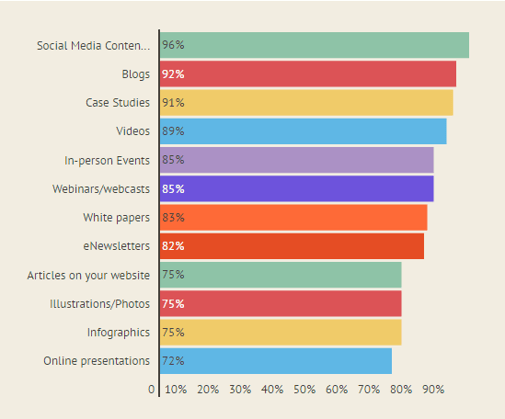3 Tips For Better B2B Technology Marketing Case Studies
Case studies are an important arrow in the arsenal of a B2B technology marketer. Knowing how to write one well–or being able to spot shortfalls in case studies written by your agency–is an important skill.
I’ve written and overseen the writing of hundreds of technology case studies in the last decade. And I’ve learnt that, although there’s plenty of art to it, a lot can be boiled down to some simple guides.
TECHNOLOGY MARKETER’S CONTENT MARKETING TACTIC USAGE
Case studies are the third most-preferred content format among technology marketing executives.

But first, why the focus on case studies? Why are they so important to us B2B marketers, especially those in technology?
The short answer: Because our educated audiences are attracted to them.
B2B marketers are keenly aware of the importance of case studies in building up trust in their products. According to a survey from the Content Marketing Institute, 91% of B2B marketing professionals use case studies—making it the third most-used content format in B2B marketing.
And just under 70% of B2B buyers say they have read case studies to research B2B purchasing decisions, according to survey Demand Gen Report, a publishing house focused on B2B marketing.
According to same survey, B2B buyers said case studies were the most valuable online content format for researching B2B purchases—beating other formats including whitepapers, e-books, and RoI calculators.
So how do you get case studies, this most valuable content format among B2B buyers, right? Here are a few tips.
Introduce the Benefit Straightaway
Don’t leave the best part for the last. This isn’t a dessert, and we aren’t at a buffet.
Be upfront about the benefits of a case study. If a remote support tool increased first-call resolution rates by 30% for a customer, then it’s a good practice for your case study says so within the first two paragraphs.
A lot of case-study writers are reluctant to ‘give away’ the benefits of case early on because they believe they’ll lose the reader and won’t be able to build suspense.
By putting ourselves in the shoes of our readers, we will realise that first, they aren’t spending their afternoon off browsing through technology case studies for the fun of it. And second, we aren’t John Grisham and creating suspense isn’t really the primary aim of a case study. Although it doesn’t hurt to have some.
Our readers are more probably looking, fairly urgently, for a solution to a problem. They understand the problem, they’ve already scoped around for possible solutions, and now they want to find out if the product we are writing about works in the real world.
That’s when they happened on our case study. (Kudos on your SEO!)
Now is not the time for us to dilly-dally. The last thing our readers want to is to waste time scanning our case study only to find that the solution we’ve been going on about is great—but doesn’t solve the specific problem they need solving.
Aim for Peer-to-Peer, But Don’t Stop There
The primary reason case studies work is because, like testimonials, they reveal how good a solution or product is in the real world.
But for technology decision-makers and influencers, typically CIOs and their IT teams, it’s important not just to hear a review, but to get it from the mouth of someone they trust.
And that means the hero of our case study has to be of the same level as the audience we are writing it for. If we’re writing for an audience of CIOs, then our case study has to be written with the CIO as it’s central character.
Most good case study writers instinctively know this. And stop there.
How our readers wish they didn’t.
Most technology solutions and products are meant to solve business problems. Which is why it’s a good practice to get some quotes from a line-of-business executive.
If a new CRM increased up-selling opportunities, then we should get a sales head to say so.
Depending on the case study, it might also be a good idea to find quotes from customers or other stakeholders like suppliers.
Humanise Case Studies
There are so many case studies out there that merely hit the basic notes: Organisational description, business problem, technology solution, and benefits.
Cardinal mistake.
In visual media, they say that nothing is quite as captivating as the picture of another person or the eyes of another human being.
Humans are hard-wired to listen to the stories of the lives of other people. That’s why all good story-telling is about people—not technology.
At the BBC, reporters are trained to ask this one question every time they come across a new story: Who’s the face of the story?
Humanising every story, that’s what it comes down to.
Have you noticed how on talk shows like Jimmy Kimmel and Stephen Colbert, the hosts spend a majority of their interview with celebrities asking them about their lives, their beliefs? When, in fact, celebrities are there to pitch an upcoming movie, book, or album? That’s because audiences are more interested in the story of other people’s lives.
Using a story as an anchor is also a trick many TED speakers use.
Getting this level of detailing isn’t as difficult or time consuming as it might seem. By merely adding a few additional questions, we can find out interesting details. Did the CIO think of the problem on his commute to work? That makes for a great description of a busy commute—something almost every one can empathise with.
Or did an IT leader face a lot of doubt from his peers when proposing a technology solution? Describing that scene is a lovely way to show the human side of a CIO, and create empathy. Who doesn’t love an underdog moment?
While this isn’t an exhaustive list of ways to bring life to a case study, I suspect it will go a long way towards making your stand out.
 ← TO THE BLOG
← TO THE BLOG
